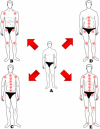Osteoarthritis in the XXIst century: risk factors and behaviours that influence disease onset and progression
- PMID: 25785564
- PMCID: PMC4394521
- DOI: 10.3390/ijms16036093
Osteoarthritis in the XXIst century: risk factors and behaviours that influence disease onset and progression
Abstract
Osteoarthritis (OA) is a growing public health problem across the globe, affecting more than half of the over 65 population. In the past, OA was considered a wear and tear disease, leading to the loss of articular cartilage and joint disability. Nowadays, thanks to advancements in molecular biology, OA is believed to be a very complex multifactorial disease. OA is a degenerative disease characterized by "low-grade inflammation" in cartilage and synovium, resulting in the loss of joint structure and progressive deterioration of cartilage. Although the disease can be dependent on genetic and epigenetic factors, sex, ethnicity, and age (cellular senescence, apoptosis and lubricin), it is also associated with obesity and overweight, dietary factors, sedentary lifestyle and sport injuries. The aim of this review is to highlight how certain behaviors, habits and lifestyles may be involved in the onset and progression of OA and to summarize the principal risk factors involved in the development of this complicated joint disorder.
Figures





References
Publication types
MeSH terms
Substances
Grants and funding
LinkOut - more resources
Full Text Sources
Other Literature Sources
Medical
Miscellaneous

